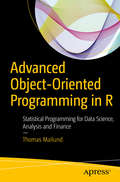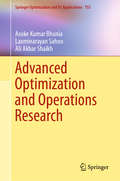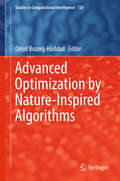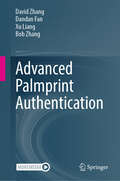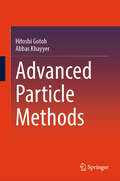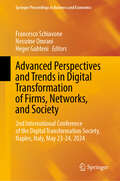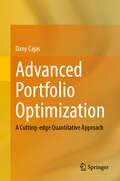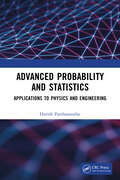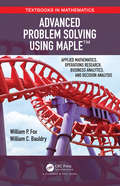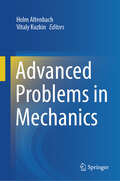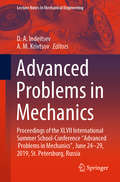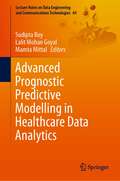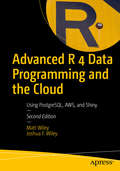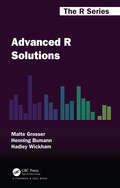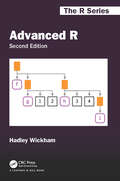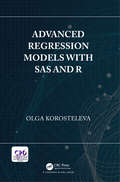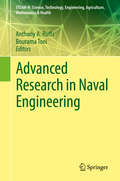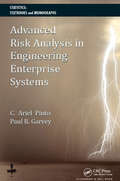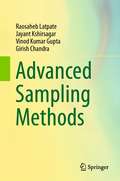- Table View
- List View
Advanced Numerical and Semi-Analytical Methods for Differential Equations
by Snehashish Chakraverty Nisha Mahato Perumandla Karunakar Tharasi Dilleswar RaoExamines numerical and semi-analytical methods for differential equations that can be used for solving practical ODEs and PDEs This student-friendly book deals with various approaches for solving differential equations numerically or semi-analytically depending on the type of equations and offers simple example problems to help readers along. Featuring both traditional and recent methods, Advanced Numerical and Semi Analytical Methods for Differential Equations begins with a review of basic numerical methods. It then looks at Laplace, Fourier, and weighted residual methods for solving differential equations. A new challenging method of Boundary Characteristics Orthogonal Polynomials (BCOPs) is introduced next. The book then discusses Finite Difference Method (FDM), Finite Element Method (FEM), Finite Volume Method (FVM), and Boundary Element Method (BEM). Following that, analytical/semi analytic methods like Akbari Ganji's Method (AGM) and Exp-function are used to solve nonlinear differential equations. Nonlinear differential equations using semi-analytical methods are also addressed, namely Adomian Decomposition Method (ADM), Homotopy Perturbation Method (HPM), Variational Iteration Method (VIM), and Homotopy Analysis Method (HAM). Other topics covered include: emerging areas of research related to the solution of differential equations based on differential quadrature and wavelet approach; combined and hybrid methods for solving differential equations; as well as an overview of fractal differential equations. Further, uncertainty in term of intervals and fuzzy numbers have also been included, along with the interval finite element method. This book: Discusses various methods for solving linear and nonlinear ODEs and PDEs Covers basic numerical techniques for solving differential equations along with various discretization methods Investigates nonlinear differential equations using semi-analytical methods Examines differential equations in an uncertain environment Includes a new scenario in which uncertainty (in term of intervals and fuzzy numbers) has been included in differential equations Contains solved example problems, as well as some unsolved problems for self-validation of the topics covered Advanced Numerical and Semi Analytical Methods for Differential Equations is an excellent text for graduate as well as post graduate students and researchers studying various methods for solving differential equations, numerically and semi-analytically.
Advanced Object-Oriented Programming in R: Statistical Programming for Data Science, Analysis and Finance
by Thomas MailundLearn how to write object-oriented programs in R and how to construct classes and class hierarchies in the three object-oriented systems available in R. This book gives an introduction to object-oriented programming in the R programming language and shows you how to use and apply R in an object-oriented manner. You will then be able to use this powerful programming style in your own statistical programming projects to write flexible and extendable software. After reading Advanced Object-Oriented Programming in R, you'll come away with a practical project that you can reuse in your own analytics coding endeavors. You'll then be able to visualize your data as objects that have state and then manipulate those objects with polymorphic or generic methods. Your projects will benefit from the high degree of flexibility provided by polymorphism, where the choice of concrete method to execute depends on the type of data being manipulated. What You'll Learn Define and use classes and generic functions using R Work with the R class hierarchies Benefit from implementation reuse Handle operator overloading Apply the S4 and R6 classes Who This Book Is For Experienced programmers and for those with at least some prior experience with R programming language.
Advanced Optimization and Operations Research (Springer Optimization and Its Applications #153)
by Asoke Kumar Bhunia Laxminarayan Sahoo Ali Akbar ShaikhThis textbook provides students with fundamentals and advanced concepts in optimization and operations research. It gives an overview of the historical perspective of operations research and explains its principal characteristics, tools, and applications. The wide range of topics covered includes convex and concave functions, simplex methods, post optimality analysis of linear programming problems, constrained and unconstrained optimization, game theory, queueing theory, and related topics. The text also elaborates on project management, including the importance of critical path analysis, PERT and CPM techniques. This textbook is ideal for any discipline with one or more courses in optimization and operations research; it may also provide a solid reference for researchers and practitioners in operations research.
Advanced Optimization by Nature-Inspired Algorithms (Studies in Computational Intelligence #720)
by Omid Bozorg-HaddadThis book, compiles, presents, and explains the most important meta-heuristic and evolutionary optimization algorithms whose successful performance has been proven in different fields of engineering, and it includes application of these algorithms to important engineering optimization problems. In addition, this book guides readers to studies that have implemented these algorithms by providing a literature review on developments and applications of each algorithm. This book is intended for students, but can be used by researchers and professionals in the area of engineering optimization.
Advanced Palmprint Authentication
by David Zhang Bob Zhang Dandan Fan Xu LiangThis book presents a comprehensive exploration of palmprint recognition, synthesizing over a decade of research in contact-based, contactless, 3D, and multispectral systems. As one of the earliest approaches in biometrics, contact-based palmprint systems have evolved significantly, achieving greater portability and accuracy, even when handling large-scale datasets. In contrast, contactless systems, which allow users to position their palms near the camera without physical contact, offer a hygienic, user-friendly alternative that has quickly gained popularity in various applications. Additionally, the advancement of 3D palmprint recognition and the introduction of cutting-edge sensors, such as line-scan and multicamera systems, have further enhanced the accuracy and reliability of these systems. This book is structured into 13 chapters, divided into three key sections. The first part delves into contact-based systems, emphasizing their growing efficiency and performance in both small devices and large-scale scenarios. The second part provides in-depth coverage of contactless systems, detailing essential processes like palmprint acquisition, ROI localization, feature extraction, and matching techniques. The third section examines the latest developments in multiple sensing systems, focusing on 3D and multispectral recognition. Targeted at researchers and engineers in biometrics, particularly those specializing in palmprint recognition, this book offers valuable insights and practical algorithms for enhancing system performance. It is also an excellent resource for readers with a broader interest in biometric technologies, offering a rich understanding of the latest trends and innovations in the field.
Advanced Particle Methods
by Hitoshi Gotoh Abbas KhayyerThis book provides an in-depth, comprehensive, and comprehensible description of the theoretical background and numerical methodologies corresponding to advanced particle methods formulated in classical Newtonian mechanics for simulation of fluids, structures, and their interactions. Particle methods are regarded as new-generation computational technology with a broad range of applications in engineering and science. Advanced particle methods refer to the latest developed particle methods with high stability, accuracy, conservation, and convergence properties. Distinctively, the described advanced particle methods are characterized by a clear, consistent mathematical–physical background, the absence of artificial numerical stabilizers that often require parameter tuning, rigorous satisfaction of boundary conditions, and excellent numerical results that have been extensively and scrupulously verified with respect to reliable analytical and experimental reference solutions. This book presents a unified description for both smoothed particle hydrodynamics (SPH) and moving particle semi-implicit (MPS) methods through a coherent presentation of fundamental equations, and numerical algorithms and schemes. Special attention is devoted to meticulous and coherent explanation of the advanced particle methods such that even undergraduate students can follow the derivation process and thoroughly understand the concepts and equations. The state-of-the-art particle method technology is also portrayed with the presentation of developed multi-physics, multi-scale particle methods corresponding to multi-phase flows, and hydroelastic fluid–structure interactions with rigorous treatment of interfacial moving boundaries.
Advanced Perspectives and Trends in Digital Transformation of Firms, Networks, and Society: 2nd International Conference of the Digital Transformation Society, Naples, Italy, May 23-24, 2024 (Springer Proceedings in Business and Economics)
by Francesco Schiavone Nessrine Omrani Heger GabteniThis book provides a comprehensive review and a detailed snapshot of the newly emerging research trends and evidence about digital transformation in organizations, networks, and social groups. Featuring select best papers presented at the 2nd International Conference of the Digital Transformation Society (DTS) held in Naples, Itay in May 2024, the enclosed chapters explore the role of digital transformation in areas such as value creation; artificial intelligence (AI), and generative AI for the work and processes of the future; Internet of Things; big data management and valuation; digital business models; responsible AI and ethic; AI and Sustainable Development Goals (SDGs); smart mobility and transportation; smart cities; digital marketing; human resource management (HRM); and metaverse, among others. The book is a rich source of new evidence and concepts on digital transformation and an important reading for all scholars and practitioners interested in technology and innovation management.
Advanced Portfolio Optimization: A Cutting-edge Quantitative Approach
by Dany CajasThis book is an innovative and comprehensive guide that provides readers with the knowledge about the latest trends, models and algorithms used to build investment portfolios and the practical skills necessary to apply them in their own investment strategies. It integrates latest advanced quantitative techniques into portfolio optimization, raises questions about which alternatives to modern portfolio theory exists and how they can be applied to improve the performance of multi-asset portfolios. It provides answers and solutions by offering practical tools and code samples that enable readers to implement advanced portfolio optimization techniques and make informed investment decisions. Portfolio Optimization goes beyond traditional portfolio theory (Quadratic Programming), incorporating last advances in convex optimization techniques and cutting-edge machine learning algorithms. It extensively addresses risk management and uncertainty quantification, teaching readers how to measure and minimize various forms of risk in their portfolios. This book goes beyond traditional back testing methodologies based on historical data for investment portfolios, incorporating tools to create synthetic datasets and robust methodologies to identify better investment strategies considering real aspects like transaction costs. The author provides several methodologies for estimating the input parameters of investment portfolio optimization models, from classical statistics to more advanced models, such as graph-based estimators and Bayesian estimators, provide a deep understanding of advanced convex optimization models and machine learning algorithms for building investment portfolios and the necessary tools to design the back testing of investment portfolios using several methodologies based on historical and synthetic datasets that allow readers identify the better investment strategies.
Advanced Probability Theory, Second Edition, (Probability: Pure And Applied Ser. #10)
by Janos GalambosThis work thoroughly covers the concepts and main results of probability theory, from its fundamental principles to advanced applications. This edition provides examples early in the text of practical problems such as the safety of a piece of engineering equipment or the inevitability of wrong conclusions in seemingly accurate medical tests for AIDS and cancer.
Advanced Probability and Statistics: Applications to Physics and Engineering
by Harish ParthasarathyThis book surveys some of the important research work carried out by Indian scientists in the field of pure and applied probability, quantum probability, quantum scattering theory, group representation theory and general relativity. It reviews the axiomatic foundations of probability theory by A.N. Kolmogorov and how the Indian school of probabilists and statisticians used this theory effectively to study a host of applied probability and statistics problems like parameter estimation, convergence of a sequence of probability distributions, and martingale characterization of diffusions. It will be an important resource to students and researchers of Physics and Engineering, especially those working with Advanced Probability and Statistics.
Advanced Probability and Statistics: Remarks and Problems
by Harish ParthasarathyThe chapters in this book deal with: Basic formulation of waveguide cavity resonator equations especially when the cross sections of the guides and resonators have arbitrary shapes. The focus is on expressing the total field energy within such a cavity resonator as a quadratic form in the complex coefficients that determine the modal expansions of the electromagnetic field. The reviews of basic statistical signal processing covering linear models, fast algorithms for estimating the parameters in such linear models, applications of group representation theory to image processing problems especially the representations of the permutation groups and induced representation theory applied to image processing problems involving the three dimensional Euclidean motion group. The Hartree-Fock equations for approximately solving the two electron atomic problem taking spin-orbit magnetic field interactions into account has been discussed. In the limit as the lattice tends to a continuum, the convergence of the stochastic differential equations governing interacting particles on the lattice to a hydrodynamic scaling limit. It will be useful to undergraduate and postgraduate students with courses on transmission lines and waveguides, and statistical signal processing. Print edition not for sale in South Asia (India, Sri Lanka, Nepal, Bangladesh, Pakistan or Bhutan).
Advanced Problem Solving Using Maple: Applied Mathematics, Operations Research, Business Analytics, and Decision Analysis (Textbooks in Mathematics)
by William Bauldry William P FoxAdvanced Problem Solving Using Maple™: Applied Mathematics, Operations Research, Business Analytics, and Decision Analysis applies the mathematical modeling process by formulating, building, solving, analyzing, and criticizing mathematical models. Scenarios are developed within the scope of the problem-solving process. The text focuses on discrete dynamical systems, optimization techniques, single-variable unconstrained optimization and applied problems, and numerical search methods. Additional coverage includes multivariable unconstrained and constrained techniques. Linear algebra techniques to model and solve problems such as the Leontief model, and advanced regression techniques including nonlinear, logistics, and Poisson are covered. Game theory, the Nash equilibrium, and Nash arbitration are also included. Features: The text’s case studies and student projects involve students with real-world problem solving Focuses on numerical solution techniques in dynamical systems, optimization, and numerical analysis The numerical procedures discussed in the text are algorithmic and iterative Maple is utilized throughout the text as a tool for computation and analysis All algorithms are provided with step-by-step formats About the Authors: William P. Fox is an emeritus professor in the Department of Defense Analysis at the Naval Postgraduate School. Currently, he is an adjunct professor, Department of Mathematics, the College of William and Mary. He received his PhD at Clemson University and has many publications and scholarly activities including twenty books and over one hundred and fifty journal articles. William C. Bauldry, Prof. Emeritus and Adjunct Research Prof. of Mathematics at Appalachian State University, received his PhD in Approximation Theory from Ohio State. He has published many papers on pedagogy and technology, often using Maple, and has been the PI of several NSF-funded projects incorporating technology and modeling into math courses. He currently serves as Associate Director of COMAP’s Math Contest in Modeling (MCM).
Advanced Problem Solving with Maple: A First Course (Textbooks in Mathematics)
by William Fox William BauldryProblem Solving is essential to solve real-world problems. Advanced Problem Solving with Maple: A First Course applies the mathematical modeling process by formulating, building, solving, analyzing, and criticizing mathematical models. It is intended for a course introducing students to mathematical topics they will revisit within their further studies. The authors present mathematical modeling and problem-solving topics using Maple as the computer algebra system for mathematical explorations, as well as obtaining plots that help readers perform analyses. The book presents cogent applications that demonstrate an effective use of Maple, provide discussions of the results obtained using Maple, and stimulate thought and analysis of additional applications. Highlights: The book’s real-world case studies prepare the student for modeling applications Bridges the study of topics and applications to various fields of mathematics, science, and engineering Features a flexible format and tiered approach offers courses for students at various levels The book can be used for students with only algebra or calculus behind them About the authors: Dr. William P. Fox is an emeritus professor in the Department of Defense Analysis at the Naval Postgraduate School. Currently, he is an adjunct professor, Department of Mathematics, the College of William and Mary. He received his Ph.D. at Clemson University and has many publications and scholarly activities including twenty books and over one hundred and fifty journal articles. William C. Bauldry, Prof. Emeritus and Adjunct Research Prof. of Mathematics at Appalachian State University, received his PhD in Approximation Theory from Ohio State. He has published many papers on pedagogy and technology, often using Maple, and has been the PI of several NSF-funded projects incorporating technology and modeling into math courses. He currently serves as Associate Director of COMAP’s Math Contest in Modeling (MCM).
Advanced Problems in Mechanics
by Holm Altenbach Vitaly KuzkinThis book focuses on original theories and approaches in the field of mechanics. It is based on several lectures of the 50th Anniversary of the International Summer School-Conference "Advanced Problems in Mechanics" (June 2022, St. Petersburg, Russia), and with an emphasis on problems and solutions at the boundaries between mechanics and other areas of research. The respective chapters highlight cutting-edge work that promotes development in fields like micro- and nanomechanics, materials science, solid state physics, molecular physics, astrophysics, and many others.
Advanced Problems in Mechanics: Proceedings of the XLVII International Summer School-Conference “Advanced Problems in Mechanics”, June 24-29, 2019, St. Petersburg, Russia (Lecture Notes in Mechanical Engineering)
by D. A. Indeitsev A. M. KrivtsovThis book focuses on original theories and approaches in the field of mechanics. It reports on both theoretical and applied research, with a special emphasis on problems and solutions at the interfaces of mechanics and other research areas. The respective chapters highlight cutting-edge works fostering development in fields such as micro- and nanomechanics, material science, physics of solid states, molecular physics, astrophysics, and many others. Special attention has been given to outstanding research conducted by young scientists from all over the world. Based on the 47th edition of the international conference “Advanced Problems in Mechanics”, held on June 24–29, 2019, in St. Petersburg, Russia, and organized by Peter the Great St. Petersburg Polytechnic University and Institute for Problems in Mechanical Engineering of Russian Academy of Sciences under the patronage of Russian Academy of Sciences, the book provides researchers and graduate students with an extensive overview of the latest research and a source of inspiration for future developments in various fields of mechanics.
Advanced Prognostic Predictive Modelling in Healthcare Data Analytics (Lecture Notes on Data Engineering and Communications Technologies #64)
by Mamta Mittal Lalit Mohan Goyal Sudipta RoyThis book discusses major technical advancements and research findings in the field of prognostic modelling in healthcare image and data analysis. The use of prognostic modelling as predictive models to solve complex problems of data mining and analysis in health care is the feature of this book. The book examines the recent technologies and studies that reached the practical level and becoming available in preclinical and clinical practices in computational intelligence. The main areas of interest covered in this book are highest quality, original work that contributes to the basic science of processing, analysing and utilizing all aspects of advanced computational prognostic modelling in healthcare image and data analysis.
Advanced Quantitative Reasoning: Mathematics for the World Around Us (Texas Edition)
by Gregory D. Foley Thomas R. Butts Stephen W. Phelps Daniel A. ShowalterAdvanced Quantitative Reasoning provides a balanced approach to relevant mathematics for students entering higher education or the workforce. It balances traditional high school mathematics with statistics and modeling; quantitative literacy with financial and overall literacy; and technology-enhanced mathematics with mental and paper-and-pencil mathematics.
Advanced R 4 Data Programming and the Cloud: Using PostgreSQL, AWS, and Shiny
by Joshua F. Wiley Matt WileyProgram for data analysis using R and learn practical skills to make your work more efficient. This revised book explores how to automate running code and the creation of reports to share your results, as well as writing functions and packages. It includes key R 4 features such as a new color palette for charts, an enhanced reference counting system, and normalization of matrix and array types where matrix objects now formally inherit from the array class, eliminating inconsistencies.Advanced R 4 Data Programming and the Cloud is not designed to teach advanced R programming nor to teach the theory behind statistical procedures. Rather, it is designed to be a practical guide moving beyond merely using R; it shows you how to program in R to automate tasks. This book will teach you how to manipulate data in modern R structures and includes connecting R to databases such as PostgreSQL, cloud services such as Amazon Web Services (AWS), and digital dashboards such as Shiny. Each chapter also includes a detailed bibliography with references to research articles and other resources that cover relevant conceptual and theoretical topics.What You Will Learn Write and document R functions using R 4Make an R package and share it via GitHub or privatelyAdd tests to R code to ensure it works as intendedUse R to talk directly to databases and do complex data managementRun R in the Amazon cloudDeploy a Shiny digital dashboardGenerate presentation-ready tables and reports using RWho This Book Is ForWorking professionals, researchers, and students who are familiar with R and basic statistical techniques such as linear regression and who want to learn how to take their R coding and programming to the next level.
Advanced R Solutions (Chapman & Hall/CRC The R Series)
by Hadley Wickham Malte Grosser Henning BumannThis book offers solutions to all 284 exercises in Advanced R, Second Edition. All the solutions have been carefully documented and made to be as clear and accessible as possible. Working through the exercises and their solutions will give you a deeper understanding of a variety of programming challenges, many of which are relevant to everyday work. This will expand your set of tools on a technical and conceptual level. You will be able to transfer many of the specific programming schemes directly and will discover far more elegant solutions to everyday problems. Features: When R creates copies, and how it affects memory usage and code performance Everything you could ever want to know about functions The differences between calling and exiting handlers How to employ functional programming to solve modular tasks The motivation, mechanics, usage, and limitations of R's highly pragmatic S3 OO system The R6 OO system, which is more like OO programming in other languages The rules that R uses to parse and evaluate expressions How to use metaprogramming to generate HTML or LaTeX with elegant R code How to identify and resolve performance bottlenecks
Advanced R, Second Edition (Chapman & Hall/CRC The R Series)
by Hadley WickhamAdvanced R presents useful tools and techniques for attacking many types of R programming problems, helping you avoid mistakes and dead ends. With more than ten years of experience programming in R, the author illustrates the elegance, beauty, and flexibility at the heart of R. The book develops the necessary skills to produce quality code that can be used in a variety of circumstances. You will learn: The fundamentals of R, including standard data types and functions Functional programming as a useful framework for solving wide classes of problems The positives and negatives of metaprogramming How to write fast, memory-efficient code
Advanced Regression Models with SAS and R
by Olga KorostelevaAdvanced Regression Models with SAS and R exposes the reader to the modern world of regression analysis. The material covered by this book consists of regression models that go beyond linear regression, including models for right-skewed, categorical and hierarchical observations. The book presents the theory as well as fully worked-out numerical examples with complete SAS and R codes for each regression. The emphasis is on model accuracy and the interpretation of results. For each regression, the fitted model is presented along with interpretation of estimated regression coefficients and prediction of response for given values of predictors. Features: Presents the theoretical framework for each regression. Discusses data that are categorical, count, proportions, right-skewed, longitudinal and hierarchical. Uses examples based on real-life consulting projects. Provides complete SAS and R codes for each example. Includes several exercises for every regression. Advanced Regression Models with SAS and R is designed as a text for an upper division undergraduate or a graduate course in regression analysis. Prior exposure to the two software packages is desired but not required. The Author:Olga Korosteleva is a Professor of Statistics at California State University, Long Beach. She teaches a large variety of statistical courses to undergraduate and master’s students. She has published three statistical textbooks. For a number of years, she has held the position of faculty director of the statistical consulting group. Her research interests lie mostly in applications of statistical methodology through collaboration with her clients in health sciences, nursing, kinesiology, and other fields.
Advanced Research in Naval Engineering (STEAM-H: Science, Technology, Engineering, Agriculture, Mathematics & Health)
by Bourama Toni Anthony A. RuffaThis multidisciplinary volume features invited contributions on mathematical applications in naval engineering. Seeking a more holistic approach that transcends current scientific boundaries, leading experts present interdisciplinary instruments and models on a broad range of topics. Each chapter places special emphasis on important methods, research directions, and applications of analysis within the field. Fundamental scientific and mathematical concepts are applied to topics such as the butterfly structure of the FFT, the acoustic impedance of pistons in a two-layer medium, deterministic batch trackers, spline equations, moving horizons estimation, membership games for planning sensor networks, statistical models of inertial sensors, random flight searches in bounded domains, the acoustics of a mixed porosity felt airfoil, and a novel aft boundary condition for a towed flexible cylinder.Carefully peer-reviewed and pedagogically presented for a broad readership, this volume is perfect for graduate and postdoctoral students interested in interdisciplinary research. Researchers in applied mathematics and sciences will find this book an important resource on the latest developments in the field. In keeping with the STEAM-H series, this volume hopes to inspire interdisciplinary understanding and collaboration.
Advanced Risk Analysis in Engineering Enterprise Systems (Statistics: A Series of Textbooks and Monographs)
by Cesar Ariel Pinto Paul R. GarveySince the emerging discipline of engineering enterprise systems extends traditional systems engineering to develop webs of systems and systems-of-systems, the engineering management and management science communities need new approaches for analyzing and managing risk in engineering enterprise systems. Advanced Risk Analysis in Engineering Enterpri
Advanced Routing of Electronic Modules (Electronic Packaging)
by Michael Pecht Yeun Tsun WongThe rapid growth of the electronic products market has created an increasing need for affordable, reliable, high-speed and high-density multi-layer printed circuit boards (PCBs). This book presents the technologies, algorithms, and methodologies for engineers and others developing the next generation of electronic products.A vision of the future in advanced electronicsAdvanced Routing of Electronic Modules provides both fundamental theory and advanced technologies for improving routing. Beginning chapters discuss approaches to approximate a minimum rectilinear Steiner tree from a minimum spanning tree and introduce ways to avoid obstacles for routing simple multi-terminal nets sequentially in a workspace. Timing delay, clock skew, and noise control requirements in signal integrity are described as well as computer-aided approaches to managing these requirements in high-speed PCB/MCM routing.Later chapters present the two-layer wiring problem, rip-up and reroute approaches, and parallel routing, including global routing, boundary crossing placement, and detailed maze routing in hardware acceleration. Data structures, data management, and algorithms for parallel routing in a multiple-processor hardware systems are also covered.
Advanced Sampling Methods
by Girish Chandra Raosaheb Latpate Jayant Kshirsagar Vinod Kumar GuptaThis book discusses all major topics on survey sampling and estimation. It covers traditional as well as advanced sampling methods related to the spatial populations. The book presents real-world applications of major sampling methods and illustrates them with the R software. As a large sample size is not cost-efficient, this book introduces a new method by using the domain knowledge of the negative correlation between the variable of interest and the auxiliary variable in order to control the size of a sample. In addition, the book focuses on adaptive cluster sampling, rank-set sampling and their applications in real life. Advance methods discussed in the book have tremendous applications in ecology, environmental science, health science, forestry, bio-sciences, and humanities. This book is targeted as a text for undergraduate and graduate students of statistics, as well as researchers in various disciplines.

